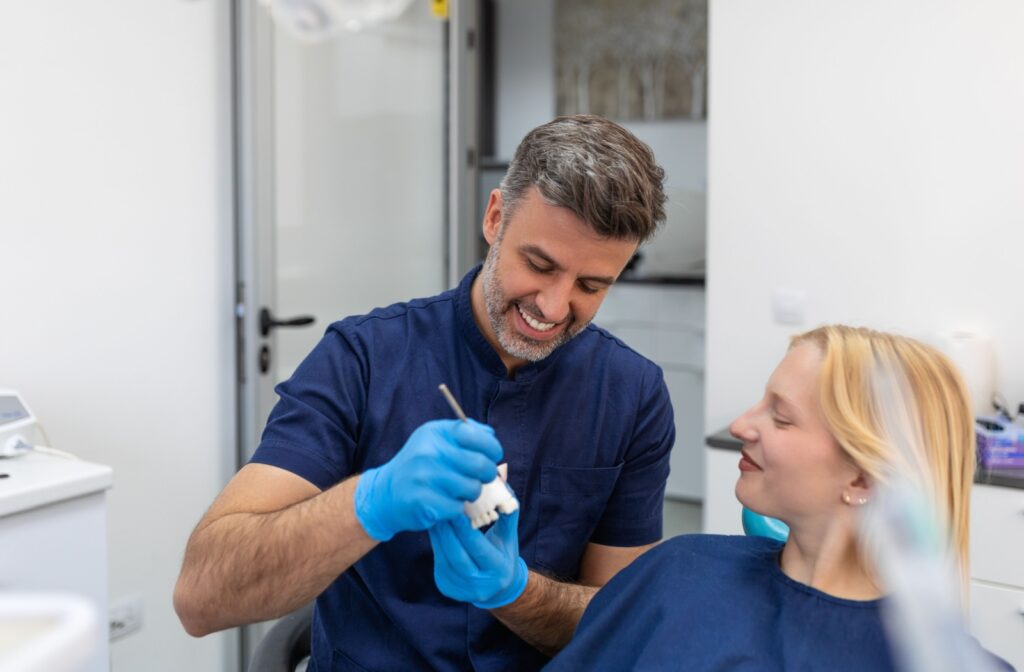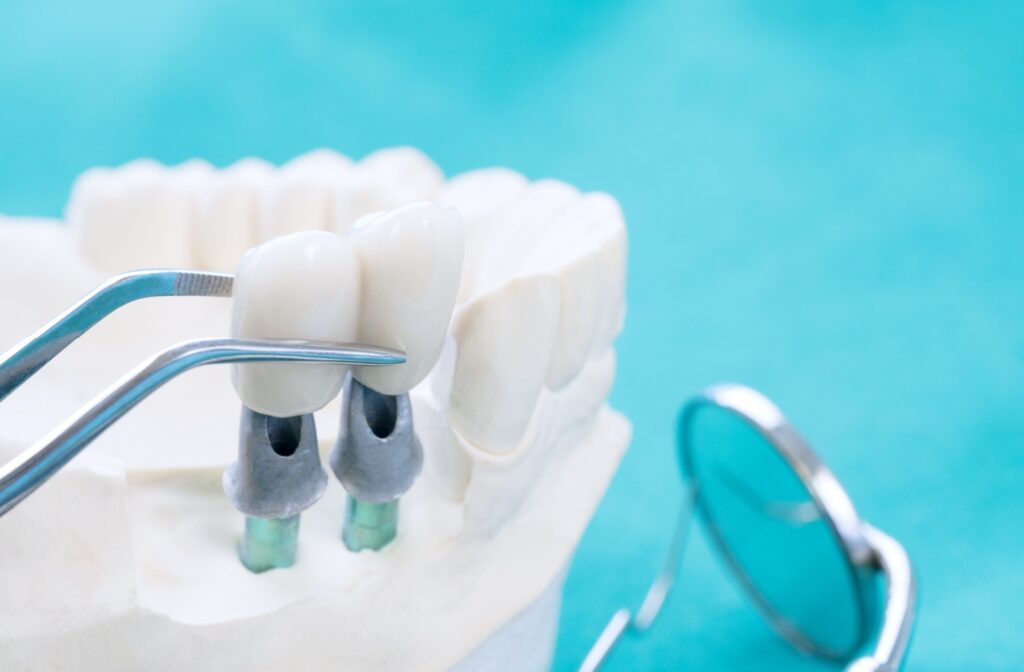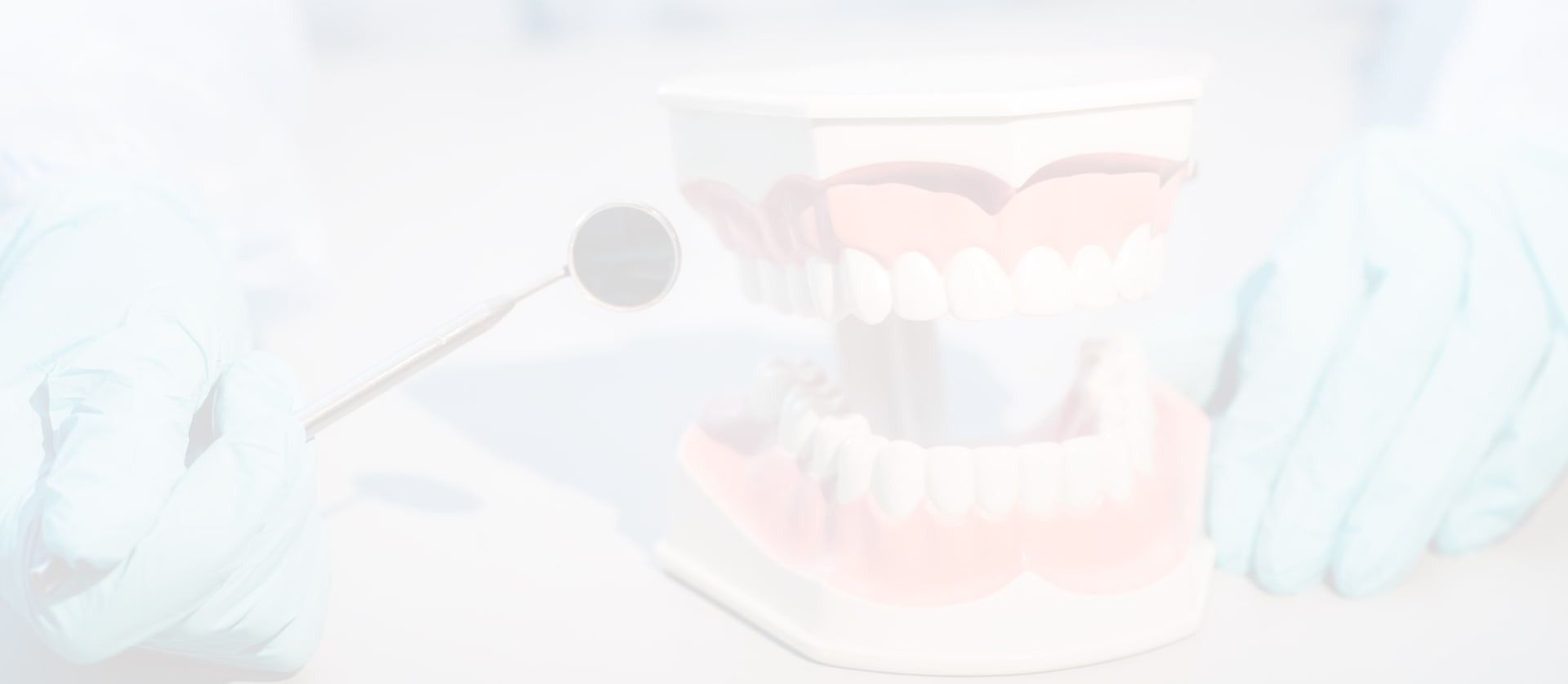Dental bridges are vital in restoring smiles and proper oral functionality. Whether you’ve recently received a dental bridge or have had one for years, understanding how to care for it is essential to maintain its function and appearance. Proper cleaning and caring for a dental bridge typically includes:
- Brushing twice daily
- Flossing teeth and under the bridge
- Using an interdental brush
- Rinsing with a suitable mouthwash
Proper cleaning and upkeep can help safeguard your oral health, prevent potential issues, and extend the life of your dental bridge.
If you notice any signs of tooth decay or other possible problems, it’s essential to consult with your dentist. They can examine your teeth, gums, and dental bridge and detect potential complications before they progress.
What Are Dental Bridges?
A dental bridge is a fixed dental restoration designed to replace 1 or more missing teeth. It bridges the gap left by missing teeth using artificial teeth supported by adjacent natural teeth or implants. Dental bridges are commonly used in cases where tooth loss has affected chewing, speaking, or the aesthetic appearance of the smile.
Your dentist does everything possible to make these structures durable and functional, but a dental bridge’s success depends heavily on regular cleaning and proper care. Failure to maintain a dental bridge can lead to oral health issues, such as gum infections, tooth decay in supporting teeth, or even the bridge’s failure.
Types of Dental Bridges
There are various types of dental bridges, and the care instructions can differ slightly based on the type you have.
Traditional Dental Bridges
A traditional dental bridge relies on 2 crowns on the teeth adjacent to the gap. It’s highly durable and frequently made from materials like porcelain, metal, or a porcelain-fused-to-metal combination.
Cantilever Bridges
Unlike traditional bridges, a single, adjacent tooth supports cantilever bridges. With less support, a cantilever bridge isn’t as strong as a conventional bridge. But it’s often suitable for areas of the mouth with less bite pressure.
Maryland Bonded Bridges
This bridge uses metal or porcelain wings bonded to the back of neighbouring teeth to hold the artificial tooth in place. Maryland bridges require minimal alterations to adjacent teeth but may be less durable than other types. Your dentist may opt for a Maryland bridge when replacing front teeth, where forceful biting isn’t required.
Implant-Supported Bridges
Implant-supported bridges are anchored to dental implants rather than natural teeth and are typically considered the most stable option. These are particularly useful for people who have several missing teeth. An implant-supported bridge is similar to a traditional bridge, except for how it mounts.

Why Regular Cleaning Is Essential
Dental bridges aren’t immune to oral health issues. Keeping your bridge clean should be a priority.
Prevention of Gum Disease
Food particles and bacteria stuck around your bridge can lead to gum inflammation, known as gingivitis. This can progress into periodontitis, a more severe gum disease that requires a dentist’s intervention.
Avoiding Decay
Natural teeth that support a dental bridge are still susceptible to decay. Left unchecked, this can compromise the entire dental bridge structure.
Extending the Life of the Bridge
A well-maintained bridge can last significantly longer. Proper oral hygiene minimizes wear and tear, keeping the restoration functional and natural-looking.
Cleaning Your Dental Bridge
Caring for a dental bridge doesn’t have to be complicated. Start by gathering the right tools:
- A soft-bristled toothbrush
- Fluoride toothpaste
- Floss threaders or specialized dental bridge floss
- An interdental brush
- Antimicrobial mouthwash
Remember, consistency is the key. Incorporate these steps into your daily routine to keep your dental bridge in pristine condition.
Brush Twice Daily
Use a soft-bristled toothbrush and fluoride toothpaste to gently clean your dental bridge. Ensure you clean the bridge’s surface and the area underneath to prevent food and bacteria buildup.
Floss Between Teeth & Under the Bridge
Floss threaders can work well when cleaning under your bridge. Thread the floss gently beneath the bridge to remove plaque and trapped food particles. Move it back and forth to clean it thoroughly without damaging the bridge.
Use an Interdental Brush
An interdental brush can effectively remove debris between the bridge and neighbouring teeth.
Rinse with Mouthwash
Finish your cleaning routine with an antimicrobial or fluoride mouthwash to kill bacteria in your mouth and protect your gums and teeth. Keep in mind that mouthwash doesn’t replace proper brushing and flossing.
Additional Tips for Long-Term Care
Taking care of your dental bridge involves more than just daily cleaning. Here are some additional steps to prolong its life and maintain your oral health.
Maintain Regular Dental Checkups
Visit your dentist at least twice per year—or as recommended—to ensure your dental bridge is functioning well and that no underlying issues have developed.
Avoid Hard or Sticky Foods
Chewing on hard candies or sticky foods can damage the bridge or supporting teeth. Consider cutting difficult-to-chew foods into smaller pieces.
Practice Overall Oral Hygiene
Brushing and flossing isn’t just for your dental bridge. Include the rest of your teeth in this daily activity to prevent decay and gum disease from affecting your bridge and surrounding structures.
Use a Night Guard if Needed
If you grind your teeth at night, your dentist may recommend wearing a night guard to protect your dental bridge from damage.
Invest in Your Smile
Proper care can extend the life of a dental bridge and your surrounding teeth. By incorporating these cleaning techniques and tips into your routine, you can enjoy a healthy, functional smile for years to come. If you want personalized advice on properly caring for your bridge or if you have any concerns, contact our team at Fairlawn Dental Centre today and book an appointment. Dr Jaleel or one of our experienced hygienists can examine your mouth and offer tailored advice to address your concerns.










